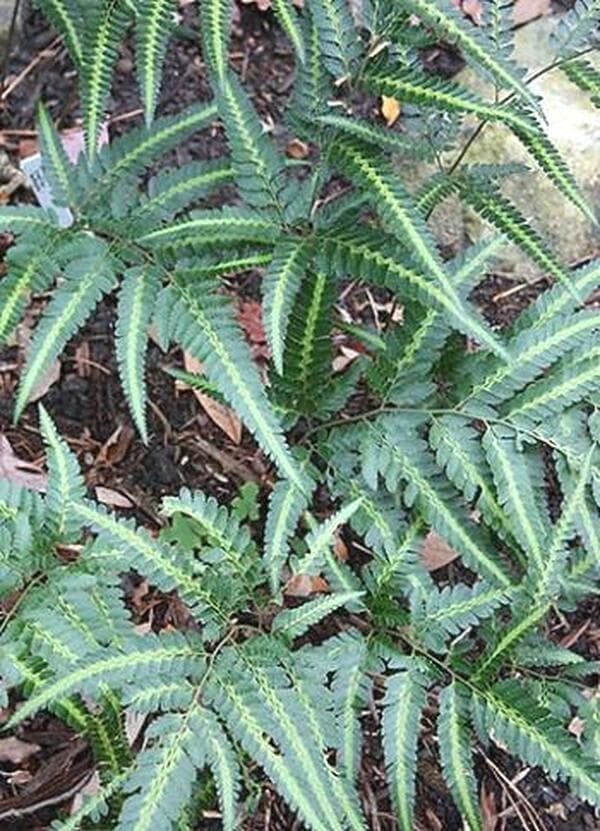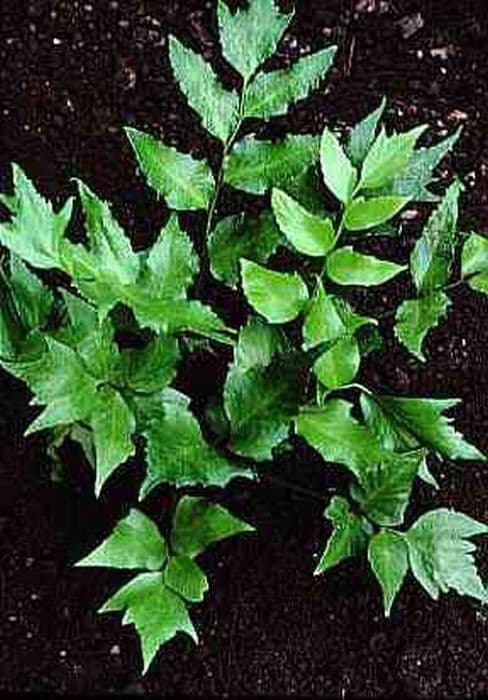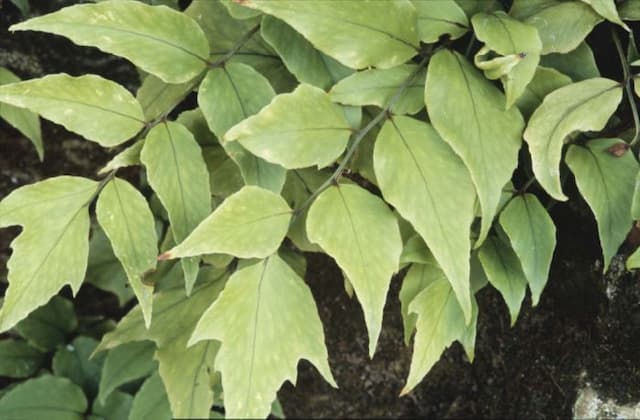Male fern Dryopteris filix-mas











ABOUT
The plant commonly known as male fern boasts an eye-catching arrangement of rich green, leathery leaves, which unfurl from a central crown to create an elegant, arching form. The leaves, or fronds, display a feathery texture and are precisely divided into numerous smaller leaflets, giving them their characteristic lush, voluminous appearance. These leaflets line the frond's stalk on either side in a balanced, symmetrical fashion. The fronds themselves emerge coiled in tight, spiral shapes known as fiddleheads, which gradually unfurl as they mature. The underside of each frond features small, discrete spots that house the plant's reproductive spores, adding a subtle textural detail to its undersurface. Overall, the male fern presents a classic fern aesthetic with its verdant color palette and delicate, intricate leaf patterns.
About this plant
 Names
NamesFamily
Dryopteridaceae.
Synonyms
Male Fern, Shield Fern, Common Male Fern, Basket Fern, Bear's Paw, Knotty Brake, Sweet Brake, Worm Fern.
Common names
Aspidium filix-mas, Dryopteris filix-mas subsp. vulcanica, Nephrodium filix-mas, Polystichum filix-mas.
 Toxicity
ToxicityTo humans
Male fern (Dryopteris filix-mas) is considered mildly toxic when ingested by humans. The plant contains compounds that can act as irritants or allergens. Symptoms of male fern poisoning could include digestive upset, such as nausea, vomiting, diarrhea, and abdominal pain. Prolonged or large quantity ingestion may lead to more severe symptoms such as weakness and disorders of the central nervous system. While not typically fatal, consuming male fern should be avoided, and medical attention should be sought if symptoms arise after ingestion.
To pets
Male fern (Dryopteris filix-mas) poses a level of toxicity to pets similar to humans. In general, it is mildly toxic and can cause symptoms such as vomiting, diarrhea, abdominal pain, and hypersalivation if ingested by pets. As with humans, consumption of large amounts could potentially lead to more serious effects, including weakness or alterations in the central nervous system. If a pet ingests male fern, it is advisable to consult a veterinarian, especially if the aforementioned symptoms are observed.
 Characteristics
CharacteristicsLife cycle
Perennials
Foliage type
Evergreen
Color of leaves
Green
Height
3 feet [91 cm]
Spread
2 feet [61 cm]
Plant type
Fern
Hardiness zones
4
Native area
Europe
Benefits
 General Benefits
General Benefits- Eco-Friendly Landscaping: Male fern is a native plant in many areas, and using it in landscaping supports local ecosystems.
- Shade Tolerance: This fern thrives in shady areas, making it an ideal ground cover for woodland gardens.
- Soil Erosion Control: The fern's root system helps stabilize soil and prevent erosion, especially on slopes.
- Aesthetic Appeal: Male fern adds a lush, green appearance to gardens with its attractive, arching fronds.
- Drought Resistance: Once established, it can be quite tolerant of dry conditions, requiring minimal watering.
- Low Maintenance: Dryopteris filix-mas requires little care, making it a convenient choice for gardeners.
- Habitat Support: It provides cover and habitat for small wildlife and beneficial insects.
- Seasonal Interest: The fronds change in color and appearance with the seasons, adding year-round interest.
 Medical Properties
Medical Properties- Anthelmintic: Dryopteris filix-mas has been historically used to expel worms (anthelmintic action), particularly tapeworms from the digestive system.
- Astringent: The plant contains astringent properties which may be useful in stopping bleeding or diarrhea.
- Purgative: It has been used to induce the evacuation of the bowels (purgative effect).
 Air-purifying Qualities
Air-purifying QualitiesThis plant is not specifically known for air purifying qualities.
 Other Uses
Other Uses- Dye Production: Dryopteris filix-mas, commonly known as Male Fern, has been used historically to produce a green dye for textiles.
- Animal Bedding: The fern can be dried and used as bedding for small animals and livestock due to its soft texture and absorbency.
- Horticultural Mulch: The fronds of Dryopteris filix-mas can be used as a decorative mulch in gardens, offering aesthetic appeal and retaining soil moisture.
- Fernery Displays: Enthusiasts of ferns often use Male Fern in fernery displays, which are specialized gardens showcasing the beauty and diversity of fern species.
- Livestock Feed: In some regions, Dryopteris filix-mas has been used as an emergency feed for livestock, although care must be taken due to potential toxicity.
- Potting Mix Ingredient: The decomposed fronds make a rich component of potting mixes, providing good structure and moisture retention for container plants.
- Fern Crafts: The distinct frond patterns of the Male Fern can be used in pressed fern artwork, lending a natural and unique touch to craft projects.
- Soil Erosion Control: As a robust shade-loving plant, it can help prevent soil erosion in woodland areas or on slopes.
- Moth Deterrent: Historically, the dried fronds were believed to repel moths and were placed among garments and textiles for protection.
- Christmas Decoration: During the Victorian era, fronds of Dryopteris filix-mas were used as part of Christmas decorations due to their evergreen nature.
Interesting Facts
 Feng Shui
Feng ShuiThe Male Fern is not used in Feng Shui practice.
 Zodiac Sign Compitability
Zodiac Sign CompitabilityThe Male Fern is not used in astrology practice.
 Plant Symbolism
Plant Symbolism- Protection: Dryopteris filix-mas, commonly known as Male Fern, has been associated with protection due to its hardy nature and ability to thrive in shaded forests, offering a sense of shelter and defense against the elements.
- Secret Bond: With its intricate fronds and the tendency to grow in secluded areas, the Male Fern symbolizes a hidden or secret bond or relationship.
- Health and wellness: Historically, the Male Fern was used for medicinal purposes, and because of this, it represents health and wellness.
- Perseverance: As a plant that can withstand challenging conditions, the Male Fern symbolizes resilience and the ability to persevere through tough times.
- Masculinity: The common name itself, Male Fern, points towards masculinity and strength, making it a symbol for male virtues and attributes.
 Water
WaterMale Fern should be watered deeply but infrequently, allowing the soil to dry out slightly between waterings. Ideally, you should water the plant with approximately one gallon per square foot every week during the active growing season, depending on humidity and temperature. In the winter, the plant requires less water, roughly half the amount compared to the growing season. Always check the top inch of soil for dryness before watering and provide ample water to reach the root zone without leaving the plant in standing water.
 Light
LightMale Fern thrives best in partial to full shade, away from direct sunlight. The ideal spot for this plant is one that receives filtered light or is under the canopy of larger trees. This fern can also adapt to low-light indoor environments, making it suitable for north-facing windows or shaded corners of a room.
 Temperature
TemperatureMale Fern prefers a temperature range between 60 to 70 degrees Fahrenheit, but can tolerate temperatures as low as 50 degrees and as high as 80 degrees Fahrenheit. To maintain optimal growth, avoid placing the plant in locations with drastic temperature changes or cold drafts. The fern is hardy in a range of outdoor conditions and can survive winter temperatures down to 20 degrees Fahrenheit.
 Pruning
PruningMale Fern requires minimal pruning, mostly to remove dead or damaged fronds to maintain plant health and aesthetic appeal. Pruning is best done in early spring before new growth begins. Cutting back the entire plant every few years encourages fresh growth and rejuvenates the fern. Pruning can be performed as necessary throughout the growing season to remove occasional brown fronds.
 Cleaning
CleaningAs needed
 Soil
SoilThe best soil mix for the Male Fern is one that is well-draining, loamy and rich in organic matter. The optimal pH range for the plant is slightly acidic to neutral, between 5.5 to 7. Amend the soil with compost or peat moss to achieve the correct texture and pH balance, ensuring the plant's root system remains healthy and is able to absorb necessary nutrients efficiently.
 Repotting
RepottingMale Ferns typically don't require frequent repotting, often every 2-3 years is enough, or when they outgrow their current pot. It's best to repot in the spring, carefully handling the delicate fronds and roots. Choose a container that's slightly larger than the previous one to give the roots enough room to grow.
 Humidity & Misting
Humidity & MistingMale Fern, also known as Male Fern, thrives in high humidity environments, preferring levels between 60-70%. It is beneficial to increase humidity around the plant, particularly in dry indoor conditions, which can be achieved by misting the fronds or using a humidity tray.
 Suitable locations
Suitable locationsIndoor
Place Male Fern in indirect light, keep the soil moist.
Outdoor
Plant in part shade, moist soil, shield from wind.
Hardiness zone
3-8 USDA
 Life cycle
Life cycleThe life cycle of Dryopteris filix-mas, commonly known as male fern, begins with the production of spores that are housed in sporangia on the underside of mature fronds. When conditions are favorable, the spores germinate into a small, heart-shaped gametophyte called a prothallus, which anchors itself to the soil and contains both male and female reproductive organs. Fertilization occurs when water allows sperm to swim to and fertilize the eggs, leading to the development of a new diploid zygote that eventually grows into the sporophyte. This young sporophyte initially grows attached to the gametophyte but eventually becomes independent as it develops roots, a rhizome, and fronds. The fern grows and matures through photosynthesis, forming characteristic large and divided fronds that are capable of reproducing once they reach maturity. The cycle continues as mature fronds produce new spores, thereby completing the life cycle of the male fern.
 Propogation
PropogationPropogation time
Spring-early summer
The most popular method of propagating the common fern Dryopteris filix-mas, commonly known as the Male Fern, is through spores. Spore collection for this species typically occurs in late summer when the spores are ripe, which is evident when the sporangia on the underside of the fronds turn brown. To propagate by spores, one must carefully collect the spores by cutting the frond and storing it in a paper bag until the spores drop. The spores are then sown on the surface of a sterilized potting mix and kept humid and in indirect light. Germination can take a few weeks to several months, and once the sporelings are large enough, they can be transplanted into individual pots. It's a method requiring patience and attention to detail but rewards with genetically unique plants.









